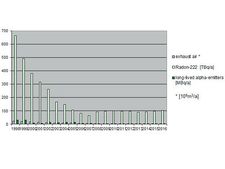-
Topics
subnavigation
Topics
Electromagnetic fields
- What are electromagnetic fields?
- Static and low-frequency fields
- Radiation protection relating to the expansion of the national grid
- High-frequency fields
- Radiation protection in mobile communication
Optical radiation
Ionising radiation
- What is ionising radiation?
- Radioactivity in the environment
- Applications in medicine
- Applications in daily life and in technology
- Effects
- What are the effects of radiation?
- Effects of selected radioactive materials
- Consequences of a radiation accident
- Cancer and leukaemia
- Genetic radiation effects
- Individual radiosensitivity
- Epidemiology of radiation-induced diseases
- Ionising radiation: positive effects?
- Risk estimation and assessment
- Radiation protection
- Nuclear accident management
- Service offers
-
The BfS
subnavigation
The BfS
- About us
- Science and research
- Laws and regulations
- BfS Topics in the Bundestag
- Links
Discharges of natural radionuclides in connection with the remediation of uranium ore mining relics (Wismut)
- An unavoidable consequence of the earlier uranium mining in Saxony and Thuringia, some natural radionuclides still occur today during and after the remediation of the affected areas. These radionuclides need to be discharged into the environment via air and water.
- The discharges are approved by the competent environment authorities; their volumes are measured and the effects on man and environment are controlled.
- The tendency of the discharged radioactivity levels is clearly decreasing; thus an impermissible risk can be ruled out.
Immediately after the end of World War II, ore mining and milling for uranium production was started in Saxony and Thuringia. After 1960, the "Soviet-German stock company Wismut" (SDAG Wismut) concentrated uranium mining in some large facilities.
In 1990, uranium mining was discontinued for radiation and environmental protection but also for economic reasons. The Wismut GmbH, whose sole shareholder is the Federal Government, was founded to prepare and implement the decommissioning and remediation of the relics that were used by the SDAG Wismut after 1962.
Emission and immission monitoring
In the process of remediating the relics (underground facilities, heaps and tailings deposits as well as contaminated operational grounds and buildings) radionuclides are also discharged via exhaust air and shaft and waste waters into the environment unavoidably. Limit values have been established for these discharges by the competent Laender authorities, whose compliance must be proved by the Wismut GmbH.

![]() Discharge of radioactive substances into surface waters from 1998 until 2016
Discharge of radioactive substances into surface waters from 1998 until 2016
Since 1997, the monitoring of the liquid and gaseous discharges and of the concentration of these substances in the environmental media air, water, sediment, soil, food of vegetable origin and feedstuffs is uniformly carried out according to the provisions of the Directive on Emission and Immission Monitoring regarding Mining.
Emission and immission monitoring, which is carried out by the Wismut GmbH and controlled by independent measuring institutions, not only serves to control the discharges and their impact on the environment but also to determine the overall situation in order to prepare further remediation decisions and to control the effects of remediation decisions.
Additionally, the Wismut GmbH performs a comprehensive monitoring in the affected regions which is continuously adapted to the state of the respective remediation works.

![]() Discharge of radioactive substances with exhaust air into the atmosphere from 1998 until 2016
Discharge of radioactive substances with exhaust air into the atmosphere from 1998 until 2016
Survey of discharge into surface waters and atmosphere
First right Figure shows a survey of the total discharge of uranium and radium-226 into the large receiving waters of the rivers Zwickauer Mulde, Elbe, Pleiße and Weiße Elster from 1998 until 2016. The discharges were within the approved yearly limits. This also accounts for the amounts of Radon-222 and long-lived alpha-emitters with discharged air (see next figure).
The inevitable discharges of Uranium, Radium-226 and Radon-222 during clean-up show a downward drift. Variations, especially in waste water, are caused by the weather or by rising floodwater.
Detailed information and data
The Federal Office for Radiation Protection (BfS) is in charge of the central compilation of results of the emission and immission monitoring. These results have to be reported by the Federal Government to the Bundestag and the Bundesrat. Detailed information and data on the topic are given in the annual Environmental Radioactivity and Radiation Exposure reports (Umweltberichte, in German only) and parliamentary reports (Parlamentsberichte, in German only).
State of 2017.08.31


